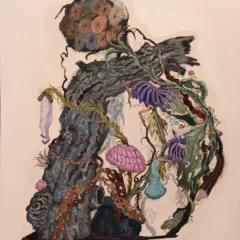By Daniel Payavis
With Richard Serra’s retrospective exhibition (it closed Sept. 10) at the Museum of Modern Art (see post) and the Philadelphia Museum of Art’s Notations: Kiefer, Polke, Richter currently up (see Look! video here), I have had ample opportunity to ponder the work of both Richter and Serra, certainly two of the most significant artists in the last thirty years. Their names reach out as far into the realm of common knowledge as contemporary artists’ names go; their work maintains international interest, yet it would seem that this is as similar as the two artists get. After all, Serra makes massive sculpture from oxidized sheets of steel and Richter’s oeuvre consists of a binary ranging from completely abstract to photo-based painting. One obvious comparison may come from similarities between Serra’s steel surfaces and Richter’s thick and seemingly alchemical abstractions (fig. 1); Richter’s abstract paintings often mimic the surface of decaying or altering material. There is a deeper and farther-reaching similarity that exists between Serra’s sculpture and Richter’s body of photographic paintings, namely an emphasis on experience. Their commentary on the experiential rather than the pictorial or imagistic makes the work of both artists extensively relevant to our time.
Serra’s emphasis on experience has been rather straightforward: as his work developed, Serra made a conscious shift from sculpture of an imagistic mode to that in which the viewer is immersed in the situation. His more recent, enormous pieces, such as his torqued ellipse series (fig. 2), demonstrate this at the highest level, and the inadequacy of photographic reproductions of his large-scale work underscores the necessity of personal interaction with them.
Richter has taken an opposite direction by making work that intentionally avoids experiential qualities. Unlike Serra, Richter has been notoriously vague about his intentions, often saying that his only aim is to make paintings. His ambiguity does not match the specificity of his photographic works which are formulaic and very much unlike the Photorealists in their blurring and fade of information (figs. 3, 4). These paintings are in actuality portraits of photographs themselves, not the image depicted by the photograph. In this way, Richter’s seemingly inexhaustible body of photographic paintings, the apparent subject matter of which ranges from any image one might see in photographic form, all point to the limited capacity for the photograph to relay visual information. From a distance, the fuzzy images urge the viewer to come closer for inspection, yet as the viewer approaches the image seems to melt away, and eyeing one from a distance of only a few inches reveals no indication of the image one sees from far away. Thus Richter declares precisely how vital painting has remained throughout the life of the photographic image, how the experiential quality of painting is what distinguishes it from other pictorial modes (photography especially).
Particularly because of new media, including film, photography, and the internet, the stress both artists place on experience and physicality has special meaning and specific indications for our culture. Pictoriality in its heyday may have been a foil to decorative modes of visual expression, and one which emphasized physical reality over idealization, and so now an emphasis on the experiential emphasizes physical reality over the elusive projected and cyber worlds. If this does not give the work of Richter and Serra a terribly important inherent meaning, it at least suggests a definitive stance on our culture’s interests.
–Daniel Payavis is a 2007 graduate of University of the Arts with a BFA in painting. He recently a post about real and painted space in Frank Stella’s work.













